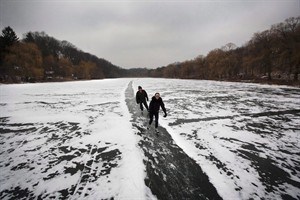
A couple skates along a path in the snow on Grenadier Pond in Toronto's High Park on December 29, 2010. THE CANADIAN PRESS/Darren Calabrese
December 02, 2014 - 10:17 AM
TORONTO - Plunging temperatures will soon make way for frozen-over waterways and community rinks, giving skating enthusiasts a chance to lace 'em up for another season.
Whether you're suiting up for shinny or out for a leisurely glide, here are some expert tips on picking the proper pair of blades.
Select styles carefully. Geoff Sarjeant said hockey skates and figure skates are meant to be "performance products" and aren't always the best choice for skating recreationally. "Rec and comfort skates" are designed for those planning to skate outdoors once a week or on a school field trip.
"The difference really is they're more comfortable when you first put your foot in there, so the foam on the side has more padding in it. It has more insulation value," said Sarjeant, senior category business manager for hockey at Canadian Tire.
"Some of our skates have Thinsulate liner in them so they'll keep you warm if you're outside say on the Rideau (Canal) or wherever else. And then you'll get a choice of different blades as well.
"So, if you're someone that's used to a figure skate blade with the picks on the end, or if you just want a hockey-style blade — which is a little bit flatter and maybe a little bit better to balance on — you can choose that as well."
Spend strategically. Individuals skating once weekly or monthly can make do with a pair that fits well but isn't as stiff, said Sarjeant.
"A $400 skate needs to be fairly durable because someone's going to be skating on that three or four times a week, whereas you can get something under $100 for sure at our stores that's going to suit the recreational market well."
Bring your socks. Sarjeant said skaters should bring the socks they plan to wear on the ice since it will change the fit of the shoe tip.
"It's pretty important," he said. "If you want to be a little bit more warm, then you would use a bit of a thicker sock, but also you lose some of that tight-fitting or better fit, too."
Wearing breathable socks will also help to pull the moisture away from your feet allowing them to stay warmer, he noted.
Ensure proper fit. Sarjeant said toes should be "feathering the toe cap" inside the skates.
"If you're feeling your heel lift up, that means the skate is probably too big," he said.
"The heel lock is what keeps it in place; so the skate will move with your foot if you have the proper fit in your heel."
Rec and comfort skates "will be snug, but not uncomfortable to put on."
"None of the materials that are used in skates — especially in these rec and comfort skates — will be expanding. So the fit you get in those will be the fit you should be used to," said Sarjeant.
Hockey or figure skates, on the other hand, need to be a bit tighter.
"You should feel it being wrapped around your whole foot, and in general, both skates fit probably one to 1 1/2 and, in some instances, two sizes underneath your shoe size."
How do you know if a child's skates are snug but not too uncomfortable? If they can't touch the toe cap, ask them to scrunch their toes up as far as they can towards the front of the skate to do so, said Sarjeant. This allows an adult to look in towards the back where their heel is positioned.
"You shouldn't have more than a finger be able to fit behind their heel," he said. "As long as you don't have that much gap, then that's good. It will even give them a little bit of room to grow as long as they don't have more than that finger width."
Sarjeant said skaters should make use of all the eyelets to help provide more support. However, he advised against wrapping laces around the ankles which results in losing "a little bit of mobility."
Break them in. "You want skates to be conformed to your feet as tight as possible," said Chris Cvar, who works in the skate shop at Vancouver's Robson Square Ice Rink. "You want them to be an extension of your body rather than just a shoe, I guess. They definitely need to be broken in."
Cvar said there are retailers who will take hockey skates, place them inside on an oven for about 15 minutes, and then allow the buyer to sit with them on, allowing the plastic to conform to their feet.
"That usually helps," he said. "It might take one or two tries, but after that, you don't want to bake them anymore. If it still doesn't work at that point, you get them punched out where they'll actually take a machine and get them to stretch out the material on the inside in order to make room for your foot."
Keep them sharpened. "Probably every three times on the ice you should check them, and it just depends on preference," Sarjeant said. "Obviously, if you're outside skating on a lake, the ice will be harder than if you're in an arena, so you'd probably need to sharpen more often if you're outside."
— With files from Canadian Press reporter Justin Smallbridge.
Follow @lauren_larose on Twitter.
News from © The Canadian Press, 2014